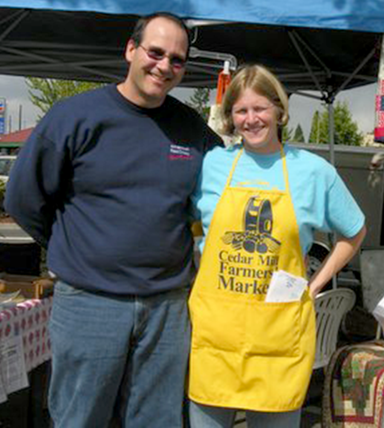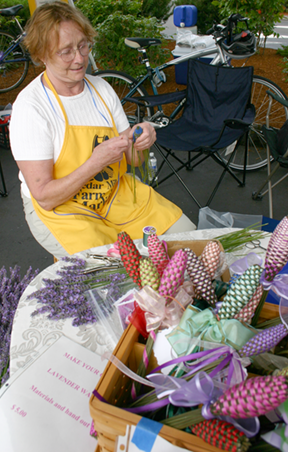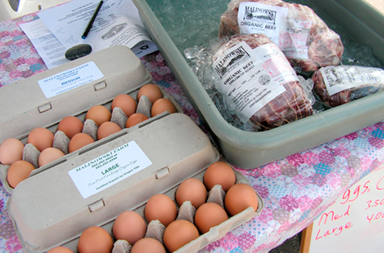Welcome to the Cedar Mill Farmers’ Market!

Vicky Siah
Pull into Safeway’s parking lot on a Saturday to see the space transformed—gone are the cars, replaced by tented outdoor shops and a vibrant, bustling community. Here, vendors call out to customers while arranging displays of lavender and bright florals; intricate, woven textiles dangle from canopies. Fresh produce lines the aisles—splashes of orange, yellow, green, and red—tantalizing passing shoppers with their ripe, bold flavors. Children, baskets in hand, hold out their POP tokens, exchanging them for natural treats.
This is the Cedar Mill Farmers’ Market, one of the oldest community gatherings in Cedar Mill.
Twenty-two years ago, Leilani Esping founded the Cedar Mill Farmers’ Market to bring the Cedar Mill community together. Leilani recalls, “This all started because I wanted to bring the world’s best fresh cherries from The Dalles, where I grew up, to the metro area. I got the idea to have a small local market. I thought a market under the overhangs at the mall would be nice, so I asked Al at the barber shop who owned the property which led me to Ryan Egge, property manager at Bales Findley Property Management. I met with Ryan and Bales agreed to having the market. From there I had a friend create the logo, put out fliers to recruit vendors, called farms, created and sent out the application, and invited local musicians to play at the market. I met Nancy Olson, co-author of “Cedar Mill History,” who recruited her son Nick and his sign business and they made our banners and so much more. The committee helped get the word out also.

Esping had been inspired by the Hollywood Farmers’ Market and envisioned the market as a place where locals could mingle and build support for Oregon farmers. In June of 1999 the market opened in the parking lot between the Cedar Mill Library and the HiSchool Pharmacy.
“Through word of mouth and fliers posted in nearby businesses, we attracted farmers and artisans to join the first market,” Leilani recalls. Vendors, including Rossi Farms, Duyck’s Peachy Pig Farm, Dot’s Bakery, Talk Rock garden art (and many more) showed up with their wares to fill the stalls. The market’s first season was a success, attracting people from all over the area, and soon, interest magnified. “Kid’s Place was a fun place for kids to enjoy kid friendly activities, and we had a huge flower pot recycling event and Blueberry Festival,” Esping recalls.
Invigorated, Leilani decided to bring the market back in 2000. But prior to the 2001 season, she received news that the Cedar Mill Library was expanding. The library would put temporary buildings in the parking lot, making it impossible for the market to continue there. The future of the market depended upon their ability to relocate.
Leilani made phone calls and visits to potential spaces, but despite their outreach, they were rejected repeatedly. It was a discouraging, slow process but they persisted. By the market’s third season, they landed in the Sunset Mall parking lot at Murray and Cornell. Safeway Manager Rick Edmunds convinced the corporation to bend their rules to allow it. He’s been a staunch supporter of the Market all along.

The market flourished in the early 2000s, attracting vendors through signage and the Cedar Mill News. In 2002-2003, both Esping and Rhonnda Edmiston, who had been the Treasurer, left the Cedar Mill area. Dina and Mark Gross, who had begun volunteering during the first season, took over the market’s management.
By 2005, finding it challenging to cope with the workload, Dina Gross approached THPRD for assistance and presented the concept of a park-sponsored market. THPRD General Manager Ron Willoughby agreed to incorporate the Cedar Mill Farmers’ Market in THPRD’s scope. Willoughby believed that helping manage the Cedar Mill Farmers’ Market would contribute to their urban service goal. The District provided funding and administrative help, along with publicity and other support.
The Grosses retired from the market mid-season in 2015 and were replaced by Danny Rodriguez. Rodriguez was previously a vendor with the Farmers’ Market, but without the direction of the markets’ founders, the market began to deteriorate. Participation in the Farmers’ Market diminished, and Jonella Malinowski, who joined the market in the mid-2000s, described the difficult situation. “It became apparent that something would have to change for [the market] to survive,” she states, citing issues with THPRD’s flexibility and market management. “We were losing vendors and customers, as well as the reputation we had for being family and community friendly.” Those who remained watched as the Cedar Mill Farmers’ Market struggled to stay afloat and their dream of a community hub dissipated.
The late 2010s proved to be the most turbulent time in the market’s existence, but even so, the market remained true to its roots. It was birthed from a movement of resiliency, and after weathering past struggles, the market’s staff refused to surrender.

A few of the remaining vendors formed a coalition. They established a formal market Board of Directors in the fall of 2015, making efforts to bring back their customer base and bring positive attention to the market’s offerings. Having invested over a decade of work into the market, these vendors were passionate about the market’s survival. They wanted the freedom to rebuild the community-oriented market that thrived in the early 2000s, and they believed in cooperative leadership. When Rodriguez resigned, the Board hired two new market managers—Karen Carroll and Lannie Thompson-Kali—to catalyze restoration efforts.
Carroll and Thompson-Kali united their skill sets to best suit the market’s needs. With the board’s support, they brought energy and experience to re-create the community vision. The management was tasked with adapting and executing solutions before the 2016 market season, a process that was often frustrating.
“We met every week in the beginning…we had to recover passwords, reset emails, formulate vendor rules, and a multitude of other things in order to have a market open in 2016,” writes Malinowski, recalling the demands of the restoration period. During that time, the market’s site shifted again—the Board simultaneously negotiated for the market’s present location at the southeast corner of the Safeway parking lot because demolition and reconstruction of a building forced the move.
The Board met regularly with THPRD to discuss the market’s future, and eventually, they developed a focus for the market. Carroll outlines the market’s two objectives as “[becoming] our own non-profit and [becoming] an independent entity again.” Under THPRD leadership, the market was bound to THPRD’s direction, and to implement a vendor-run business model, the Board felt that independence was key. In 2019, the Cedar Mill Farmers’ Market separated from THPRD as a 501(c)6 non-profit.
The Farmers’ Market has flourished since then, although they remain deeply appreciative to THPRD for their past support and guidance. An abundance of vendors applies to the market each year, and over the past seasons, the market has attracted record numbers of customers. “I am so proud of what we have accomplished,” Malinowski says. “We have back the family and community-friendly feel that we so value.”
Today, the Cedar Mill Farmers’ Market is known as one of the most hospitable farmers’ markets in the area—a center to socialize while shopping for weekend groceries. With the introduction of fun programs like the Chili Cook-Off, Pie-in-July, and Power of Produce, the Farmers’ Market appeals to people of all ages and all walks of life. Malinowski points to an increase in the SNAP population and the market’s efforts towards inclusivity. “We managed to get back our Double Up Food Bucks grant so we can double the first $10 of SNAP tokens,” she remarks. Sponsors, such as the Sunset Athletic Club, The Olive Branch, Tualatin Soil and Water Conservation District, the Farmers’ Market Fund, and others have allowed the market to cater to recent demographics. Rick Edmunds, Safeway’s manager, has given his support from the start.
Since May 2020, market practices changed to curb the spread of the pandemic. Masks, sanitation, and social distancing requirements are in place; customers browse the market in a counterclockwise direction. The market capacity is decreased, and some activities, including Chef at the Market and the music tent, have been temporarily paused. These guidelines will continue into the 2021 season, but the spirit of the market remains.
As with previous years, the market is continuously looking for community partners, either through volunteering or sponsorship. “Olive Lady” and Board Member Deborah Politi reminds us that volunteers are always needed to make the Market work. “We have a variety of positions available, and people can select dates and times they can work. We will take someone for even once a month or once a season.”
“We are an incubator market for new hot food vendors from Adelante Mujeres,” says Carroll, now the sole market manager. “We welcome new vendors and offer help/insight.”
The market has seen children grow up while old friends leave; conversely, seasons bring new faces to incorporate in the Farmers’ Market family. Those who have taken part in the market’s journey reflect on the changes that occurred through the years. The market symbolizes a project greater than any individual—it is the heart of a community that learns, helps, and creates memories together—and each person brings their own anthology of market stories. Carroll remembers her most memorable experience at the market: “I think one of the sweetest things actually happened last year—a child who comes to the market every week with her family made hero ‘badges’ for several of her favorite vendors and myself to thank us for being there. It was awesome!”

Malinowski says the market has had an interesting impact on her life. “I knew people at the market to say hi to, but being an extreme introvert, I really didn’t engage much more than that,” she says. “Now, some of them (particularly those on the board) are valued friends.”
This month marks the start of a new season, happening every Saturday between 9 am and 2 pm until October 16. The Board of Directors has worked swiftly to prepare for the market’s 2021 opening. It is a flurry of phone calls, Zoom meetings, and final checks—but on the first day of May, the market’s stalls shine once again with its characteristic, vibrant joy.
Families, with children and pets, flood in to join the festivities, packing their bags with Oregon foods, locally sourced produce, and art and craft items. They will admire each booth’s wares, make friends with the owners, and in the years to come, their children, too, will cultivate their own market recollections. Amidst the quintessential Farmers’ Market charm, newcomers may be surprised by what they find: our Cedar Mill Farmers’ Market is special, because it is a home where everyone belongs.
To learn more, visit the Market website or send an email to ourcmfm@gmail.com.





